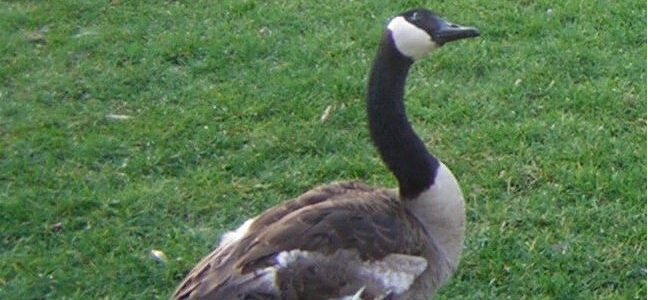
It’s very interesting how certain events in your life stick with you and are easier to recall than others. Even though it has been fifteen years, I remember the first time I helped a wild animal in distress like it was yesterday.
I had just started volunteering for my local wildlife rehabilitation center and was on my way home after spending four hours feeding baby squirrels and cleaning their enclosures. That first summer I dubbed myself “The Squirrel King.” All I did for weeks was feed babies as it was a record year for orphaned squirrel intakes. But my first rescue didn’t involve a baby squirrel; it was an adult Canada goose. I got within a mile of home when I noticed a goose on the side of the road. Most drivers would say that is not unusual, but what was unusual was that as I got close with my car, the goose didn’t move very far out of the way. So I slowed down and pulled over. Right away I noticed that the goose had a drooping wing.
I was able to get pretty close before the goose tried to run away, but not very far. It was a residential street with no immediate source of water, so I decided that I should see if I could contain the goose and bring it to the center for evaluation. But I needed a few things, a box, a sheet and some help. So I quickly drove home and got my supplies plus a reluctant roommate. I promised all I needed her to do was to hold the sheet up to make a barrier, so she agreed.
As I look back on it now, and on the calls I have been on since, I was pretty lucky for my first time. When we got back to the site the goose was still there, which was another indication that the bird was in need of help. The goose was at the curb near the driveway of a home. There were bushes on the right side and the front lawn on the left. So, I had my roommate go to the lawn area and hold out the sheet to create as big of a “wall” as she was able. I then walked slowly toward the goose with a towel outstretched in front of me. The goose did exactly what I was hoping it would, and moved right toward the garage. By this time it was dark and I had no idea if the people living in the house had any clue what we were doing. The goose tried to run away when I got within a few feet but we were too close to the garage door and there was nowhere to go but right into the towel and my arms.
I quickly wrapped the goose in a towel, to help contain and calm the bird, and got it right into the box. I took the goose to the wildlife hospital and it was determined there was some impact trauma but the goose would make a full recovery; nothing was fractured. We don’t always know the cause of an injury, but in this case it was more likely the goose had been clipped by a car. In addition to the wing droop there was some road rash and swelling in one of the legs. The goose was in our care for several weeks an then released back into the wild. As I have said my experience dealing with Canada Geese since then has showed me that my first time was very lucky. If they have the use of their wings or are near water they are almost impossible to capture.
I felt this was an important experience for me early on in my wildlife rehabilitation center. It helped me be better prepared when I was speaking to someone on the phone about a baby bird or trying to reassure the little girl standing in the wildlife hospital that “Lucky” the baby rabbit would be just fine in our care and grow up the way he was supposed to as a wild animal. I knew that every person I dealt with had the best intentions at heart and really only wanted to help, because that was what I felt when I saw that goose on the side of the road.
Helping wild animals in need is very rewarding both as the rescuer and the caregiver. I had some training in handling wild animals when I came across the injured goose, otherwise I would have made some phone calls as to the best course of action. Calling your local wildlife rehabilitation center is always the best thing to do when you find an injured or orphaned wild animal. They will be able to best guide you through what to do.
By: Michael Ginder
